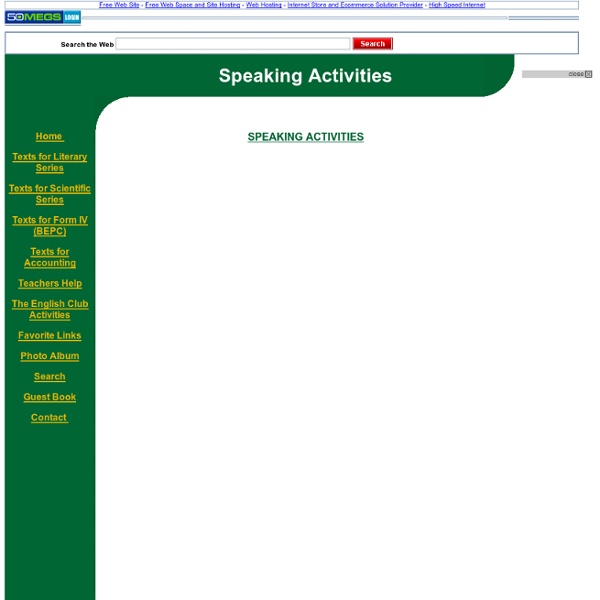Pronunciation
Welcome to EnglishClub Pronunciation for ESL learners. If your questions about pronunciation are not answered here, feel free to ask a question at the Help Each Other With English forum. pronunciation (noun): the way in which we pronounce a wordpronounce (verb): to make the sound of a word What is Pronunciation? English is not Phonetic Always remember that English is not "phonetic".
The EFL SMARTblog: Describing photos (comparing, contrasting and speculating)
You are going to practise language for; Describing photosComparing and contrasting photos (discussing similarities and differences)Speculating on what might be happeningReacting to photos (giving opinions) Discuss Look at the presentation.
Speaking
Welcome to EnglishClub.com Speaking for ESL learners, to help you learn and practise the skill of speaking English. Speaking is the second of the four language skills, which are: 1. Listening 2.
Introduction to Coordinate Graphing
Introduce elementary students to coordinate graphing through seasonal coloring activities. The fall Jack-O-Lantern activity requires students to use the grid code and crayons or markers to create a jack-o-lantern on a blank 9x9 grid. The use of letters on the horizontal axis and numbers on the vertical axis introduces young students to coordinate pairs without the confusion of the standard (h,v) format. Notice that it is important that elementary students become accustomed to listing the horizontal coordinate first as this will transfer to the Cartesian coordinates they will use in later grades. Download the Mathwire Jack-o-Lantern graphing activity. Download the Mathwire Mad Monster graphing activity.
Motivating speaking activities for lower levels
Planning time has been shown to increase production in speaking tasks. Lower level learners often find it especially difficult to speak spontaneously, so these activities incorporate 'thinking time' during which learners can prepare for speaking by planning what they are going to say, and asking the teacher or using a dictionary to look up missing vocabulary. The following activities are relatively short, with minimal materials preparation time for the teacher. They are designed for use as a warmer or a filler in the middle or at the end of a class. 1. Definitions lists
Video Lesson: Mr. Bean
Follow me on twitter This is a video lesson based around the video “Mr. Bean packs his suitcase” thanks to British Council for bringing it to my attention in their lesson plan on making predictions but I’ve adapted it for use in different ways with different levels. Kids and lower levels
Kid Conversation Starters - All Pro Dad : All Pro Dad
Sometimes being a dad is just tough. I recently had a real talk with my 8-year-old son about a kid who was trying to bully him. I don’t know if my advice was the best, but I believe it opened the door for deeper conversations in the future. You may be there, too. The time for a difficult conversation may be now. It could be the “birds and the bees” or it could be about hanging out with the wrong crew.
Speaking skills: Teaching ideas
Tips and tricks to help you prepare for English speaking practice in the classroom. Drama activitiesSix drama activities for the ELT and ESL classroom.Dramatic dialoguesUsing dialogues to practise intonation, functions and structures.First dayLindsay Clandfield provides six tried and tested speaking activities perfect for your first day with a new class.Get out of the classroom 1Ideas for outdoor lessons which will have an element of English in them.Get out of the classroom 2Ideas for outdoor lessons which will have an element of English in them.Using OKRaising students' awareness of the uses of 'OK' as a discourse marker. Students find out the disputed etymology of 'OK' and practise using it as a discourse marker.
How to get your students to speak 100% English
by David Martin This paper is written primarily for teachers who have unmotivated to semi-motivated students and want (more than anything) for their students to communicate in English from the beginning of the lesson right through to the end. This would typically include most university, junior college and high school teachers in Japan. Your first reaction may be that this is an unrealistic goal, one that you may have presented to your students before, but a goal they have always failed to achieve.
Using Silent Video in the EFL Classroom
This video is the BOMB! It is captivating, absorbing, a story par excellence but also SILENT! Yes, silent films are great for getting students to produce language — and after all is said and done, that most often is the hardest thing to do, getting the students speaking and learning language by just communicating. That is our job, to get the students so absorbed in the communicative act that they forget they are learning.
5 of My Favorite English Games for ESL Students
I saved the best for last. My students requested this game more often than any other game we ever played. It's based on the old drinking game "Ring of Fire," modified for the classroom. Materials needed:A standard deck of playing cards, a whiteboard, 20-30 small slips of blank paper, and a bowl. The setup:Almost none!
BusyTeacher.org
It’s only natural. After all, they are trying to talk in a language they are still working on learning. Still, silence can be deadly in the ESL classroom for your students and you. When you want to get your students to speak up, try one of these fun and simple games to get them talking in class.



